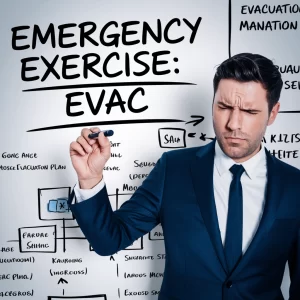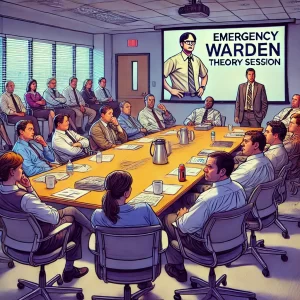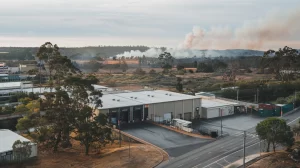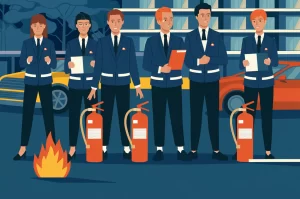Did you know that up to 75% of businesses without an emergency control organisation (ECO) struggle to handle incidents effectively? That’s a staggering number, especially considering the difference a well-formed ECO can make in critical moments. Whether it’s evacuating during a fire, managing a security threat, or responding to medical emergencies, an ECO is the backbone of a successful emergency response plan.
An ECO is essential for maintaining workplace safety and ensuring that, in the event of an emergency, your people know exactly what to do. It isn’t just about having a plan on paper—it’s about building a team that understands its roles and can act swiftly when it matters most. In this guide, we’re diving into the details of what an ECO is, how to set one up, and why AS3745 compliance is crucial. By the time you’re done reading, you’ll have a clear roadmap to building an ECO that keeps your workplace safe and ready for any crisis. Let’s get started!
What is an Emergency Control Organisation (ECO)?
An Emergency Control Organisation, or ECO, might sound technical, but at its core, it’s a structured team that manages emergencies within a building or workplace. Think of it as your own in-house team of emergency responders—people who know exactly what to do when things go sideways. Their responsibility is to ensure the safety of everyone in the building, from staff to visitors, in any emergency scenario.
But here’s the kicker: an ECO isn’t just about evacuating people when there’s a fire. They’re trained to handle everything from fires and medical incidents to security threats like intruders or bomb threats. This team is equipped to act quickly and efficiently, ensuring that the right procedures are followed and that the situation is managed with minimal risk to life and property.
ECOs are formed according to the AS3745 standard, which lays out how to effectively manage emergencies in facilities. Their job is to ensure that staff, visitors, and anyone else on-site are safe and know what to do in various emergency scenarios. The ECO operates based on clearly defined roles, including Chief Wardens, Deputy Wardens, and Area Wardens, all of whom carry specific responsibilities during an emergency.
It’s important to note that the ECO structure needs to be adapted to the size and complexity of the workplace. For example, a small office might only need a Chief Warden and a few Area Wardens, while a large multi-level building might require a more extensive team with several wardens assigned to different areas. Regardless of size, the key to a successful ECO is clear communication, training, and leadership.
The Importance of AS3745 Compliance for ECOs
Here’s the deal: AS3745 isn’t just a guideline—it’s the backbone of emergency planning and response in Australian workplaces. Being compliant with AS3745 means you’re taking all the right steps to make sure your organisation is prepared for emergencies, from fires to natural disasters. The standard outlines not only how to establish an ECO but also what procedures should be in place for evacuation, communication, and ongoing safety assessments.
Why does AS3745 matter so much? First, it’s a legal requirement for many types of buildings in Australia. Non-compliance can result in hefty fines, and worse, it can lead to devastating consequences during an emergency. But it’s not just about ticking boxes. Compliance ensures that your workplace has a robust plan in place to handle emergencies, minimising risks to life and property. In fact, being compliant could be the difference between life and death during an incident.
One key aspect of AS3745 is that it doesn’t just focus on physical safety but also on communication. Clear and effective communication is critical during emergencies, and AS3745 lays out specific protocols for how ECOs should communicate with building occupants, emergency services, and each other. This includes setting up communication systems like two-way radios, public address systems, or other reliable methods to ensure instructions are heard and followed.
Another important part of AS3745 is its emphasis on continuous improvement. ECOs aren’t a “set it and forget it” part of your emergency management plan. Regular reviews, drills, and updates are essential to ensure that your ECO remains functional and effective as the workplace evolves. Whether it’s new building layouts, staff changes, or updated emergency procedures, staying compliant with AS3745 means keeping your ECO up to date.
How to Form an ECO in Your Organisation
So, how do you actually go about forming an ECO? It’s not as daunting as it sounds. The first step is identifying the right people to fill key roles. The size and complexity of your organisation will determine how many wardens you need and the specific roles you need to fill. Here’s a step-by-step approach that’s worked for countless organisations:
- Start with Leadership: The Chief Warden is your most important appointment. This person will be your point of contact for any emergency and should have the leadership skills to handle high-stress situations. They need to be able to make quick decisions and guide others with confidence.
- Build a Team: From there, appoint Deputy Wardens and Area Wardens based on your workplace’s structure. Make sure your ECO is well-rounded and functional, with enough people to cover all areas of the building. Wardens should be reliable, level-headed individuals who can follow instructions and remain calm in emergencies.
- Train, Train, Train: An ECO is only as good as its training. Provide regular training sessions that include how to handle different emergency situations—fire, medical, security threats, and more. Each warden should be clear on their role and the procedures they need to follow.
Don’t forget to document everything. Having written procedures is critical for both AS3745 compliance and the practical functioning of your ECO. Your team should know where to find these documents and have easy access to them during an emergency.
Pro Tip: Cross-train your team! It’s easy to rely on one or two key people, but what if they’re not available when an emergency strikes? By cross-training multiple team members, you ensure that there’s always someone who can step in and manage the situation.
ECO Roles and Responsibilities Explained
ECO roles aren’t just titles—they come with serious responsibilities. Let’s break them down:
- Chief Warden: This is the go-to person during an emergency. They oversee the evacuation or shelter-in-place procedures, assess the situation, and make key decisions. The Chief Warden also communicates directly with emergency services to coordinate efforts.
- Deputy Warden: Assists the Chief Warden and takes charge if they’re unavailable. The Deputy Warden needs to be just as well-trained and prepared as the Chief Warden, ready to step in at a moment’s notice.
- Area Wardens: Responsible for ensuring that their specific zone or area of the building is cleared and safe. Area Wardens check their assigned areas, guide occupants to safety, and report back to the Chief Warden.
The responsibilities of each warden may vary slightly depending on the type of emergency. For example, in the event of a fire, Area Wardens may need to check rooms for people and ensure fire exits are accessible. During a lockdown scenario, they might need to secure their area and ensure occupants remain safely in place. The Chief Warden, on the other hand, will be overseeing the entire process, ensuring everyone knows what to do and keeping communication lines open with emergency services.
Every role in the ECO is critical. A failure at any point in the chain can lead to confusion, delays, and increased danger during an emergency. This is why training and clear communication are so essential. Make sure each warden understands not only their own responsibilities but also how they fit into the larger ECO structure.
Practical Advice for ECO Training and Drills
I can’t stress enough how vital regular training and drills are. You might have the best emergency procedures on paper, but if your ECO isn’t running through these drills regularly, they won’t be prepared when it matters most. People tend to freeze or panic in high-stress situations, and the only way to overcome that is through practice.
Start by scheduling quarterly training sessions. These don’t need to be overwhelming but should cover the basics: evacuation routes, communication systems, and role-specific tasks. Every member of your ECO needs to know where to go, who to report to, and what their responsibilities are during different types of emergencies.
Follow up with full-scale evacuation drills every six months. Make these as realistic as possible to simulate the kind of stress your team might experience in a real emergency. Don’t just stick to fire drills either—practice for different scenarios, such as medical emergencies or security threats. These drills should be evaluated afterward to identify any weaknesses or areas for improvement.
One thing I’ve learned is that it’s easy to assume people will know what to do because they’ve been briefed. The truth is, panic takes over in emergencies, and muscle memory from regular drills is what gets people to safety. When training, focus on repetition—especially when introducing new procedures. You want everyone in the ECO to be able to act without having to stop and think.
Common Mistakes in ECO Setup and How to Avoid Them
Trust me, there are some common pitfalls you’ll want to avoid when setting up your ECO. Here are the top 5:
- Understaffing Your ECO: Not having enough wardens for your building’s size is a disaster waiting to happen. Each area of the building needs to be covered, and understaffing can lead to confusion and inefficiency during an emergency.
- Lack of Training: An untrained warden is just a title without substance. Make sure training is regular and comprehensive. Don’t assume that just because someone is smart or capable in their daily role that they’ll perform well in an emergency without proper training.
- Poor Communication Systems: If your team can’t communicate during an emergency, everything falls apart. Invest in reliable communication systems, whether it’s two-way radios, intercoms, or mobile alerts. In a fast-moving situation, seconds count, and miscommunication can have serious consequences.
- No Backup Plans: What if your Chief Warden is away? What if the fire exits are blocked? Always have a Plan B (and even a Plan C). Flexibility is key in emergency management, and your ECO should be prepared for multiple outcomes.
- Ignoring Non-Emergency Scenarios: Your ECO should be prepared for more than just fires—consider medical emergencies, security threats, and natural disasters. Each scenario requires different procedures and responses, so don’t focus all your training on one type of emergency.
ECO in Action – Case Studies and Lessons Learned
I’ve seen ECOs in action during real-life emergencies, and the difference between a well-prepared team and an unprepared one is night and day. Let me share a couple of examples:
In one workplace, the Chief Warden had drilled their team regularly, so when a small fire broke out, the evacuation was smooth and efficient. Everyone knew their role, and no one panicked. The Area Wardens were able to check their zones quickly, and within minutes, the building was safely evacuated. Emergency services were impressed by how orderly and controlled the process was.
In contrast, another organisation hadn’t drilled in over a year, and during an unexpected evacuation, people were confused, unsure where to go, and hesitant to follow instructions. The Chief Warden struggled to communicate with their team, and the evacuation took much longer than it should have, putting people at risk.
The lesson? Preparation pays off. Learn from others’ mistakes and successes to make sure your ECO is ready for any scenario.
Conclusion
Setting up an ECO isn’t just about ticking boxes—it’s about creating a safer, more resilient workplace. Complying with AS3745 and putting the right people in place can mean the difference between chaos and control in an emergency. Make sure your team is trained, well-structured, and prepared for whatever comes their way.
If you’re unsure where to start or need expert guidance, Emertrix offers free 15-minute sessions with a qualified emergency manager. Whether you’re forming an ECO for the first time or refining your existing setup, our experienced team can provide tailored advice to suit your organisation’s needs. Don’t wait until it’s too late—book your free consultation today and get practical steps to improve your emergency preparedness!






